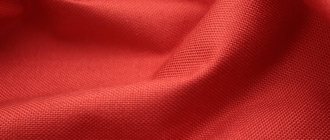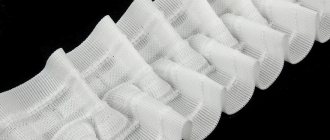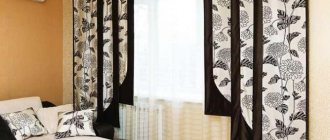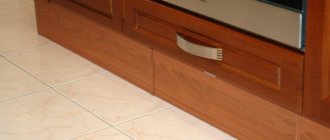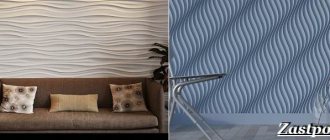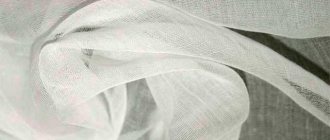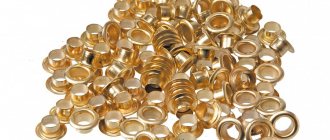A decorated window completes the image or sets the tone for the interior style of the room. Light and airy tulle plays an important role here, balancing even heavy curtains.
If you follow fashion, in Asia they prefer to close off rooms from prying eyes from the street, and in Europe they hang curtains without tulle.
Types of tulle assembly
The peculiarity of tulle curtains is the need to form neat folds. Depending on their number, shape, density, the width of the canvas can be 1.5-3 times larger than the window opening. To keep the drapery neat, a white or transparent ribbon is sewn along the top on the reverse side, which has ready-made loops for attaching to the cornice.
They are located in several rows, allowing you to make folds of any complexity. To form waves of the desired length, you can tighten the sewn braid on the sides. After this, its ends are tied, tucked under the canvas. To ensure the clarity of the side cut of light tissues, weighting agents (cords, weights) are used.
It is also possible to use other assembly methods:
- One-sided folds. The curtain is hung on hooks located at equal distances from each other. This technique is used mainly when the emphasis in the design is on the decor of the tulle itself (pattern, texture, fabric features).
- Transverse waves. To create this effect, the folds are divided into equal parts, directing small short ridges towards each other.
- Pencil. The canvas is hung on loops at regular intervals. Loop-like folds are formed.
- Bow drapery. During assembly, adjacent ridges are directed in different directions. A variation of this type of design is a voluminous glass. In this case, the fabric is straightened from above and fixed with a special filler. The bottom is gathered in 3 small folds.
- Flemish assembly. You will need braid with a double row of threads. To create the desired effect, tighten the upper and lower ones at the same time. The result should be a V-shaped knot. After this, the bottom is tightened as much as possible, leaving expressive waves at the top.
Decorative fastenings can completely transform the look of a curtain: rings, clips. Clothespins are often used as fasteners - in the form of bows, butterflies, flowers.
For a window in a children's room, manufacturers produce products in the shape of suns and teddy bears. This decor will become a spectacular accent in the interior. The photos presented in the catalogs of fittings manufacturers reflect how much these details influence the overall appearance of the curtains. However, they can be replaced without difficulty.
Benefits of using curtain tape
Curtain tape is made from different fabrics. For curtains it is made from thin materials using veil or organza
It is important that the material is thin, but has sufficient strength. Dense bases require the use of a different texture and thickness of braid
Curtain tape helps achieve the following results:
- simplify sewing curtains;
- avoid the need to sew on hook loops;
- drape fabrics of different densities and textures;
- decorate the window opening in an unusual way;
- adjust the size of the curtains.
This braid helps to get beautiful folds that are the same size and shape. After washing, the product does not shrink and retains its shape.
Curtain tape helps to carefully trim the edge and secure the product in the bedroom or in another room without using special clothespins.
Assembly size
The length of the tulle depends on the length of the cornice (standardly it protrudes 15 cm beyond the window opening) and the method of draping. Based on these parameters, the filling coefficient (density) is determined. It shows how many times the canvas is larger in size than the structure on which it is attached. The minimum indicator is 1.5, the maximum is 3.
When calculating, the density of the tulle is taken into account. If the material is thin and you can clearly see your hand through it, we buy a canvas with a filling ratio of 1:2 or higher, taking into account the type of assembly. At higher densities, this parameter can be reduced to 1:1.5.
It is also worth calculating the density of the assembly based on the method of fastening. When using curtain tape, this parameter is indicated by the manufacturer on its packaging.
The average figure, which is suitable for almost any selected window decoration option, is 1:2.5. When determining the width of the fabric, it is worth taking into account allowances for the formation of side seams on both sides of 3 cm.
To choose the right gathering density, take into account the presence of patterns on the fabric. The rule applies: the larger the pattern, the less filling the window should be curtained with.
Otherwise, it will not be possible to show the beauty of the decorative design of the curtains. The same situation applies to wall decoration. If the wallpaper has a print, the more expressive and larger it is, the easier it is to hang the tulle. Designers recommend choosing a ratio of 1:3 when choosing a plain organza, and 1:2 for a printed analogue.
Popular trends in window decoration with tulle
For many centuries, the classics have not left their leadership positions. Even the most inconspicuous and plain fabric will look great if you choose the right fittings and fasteners and know exactly how to beautifully hang tulle in a particular room. For rooms with a bright interior, tulle with photo printing will be a real find. The most interesting thing is that you can choose the design at your discretion and desire.
Tulle also goes well with a variety of curtains. The main thing is that they fit each other perfectly in shape and color.
How many meters of tulle will be needed for a three-meter window
If the canvas is placed on one rod, its width is determined by the size of the cornice without taking into account the side elements (you need to measure the distance between the fastening posts). The decorative effect when using one fabric can differ significantly. Complete with thick curtains, there are enough uniform waves without lush tails.
A standard window is 3 m wide. Therefore, manufacturers often offer ready-made curtains for such openings.
Depending on the type of assembly chosen, a canvas with a width of 4.5-9 m will be required.
When calculating, the length of the cornice rod is multiplied by a factor and 6 cm is added for allowances. If the fabric is supposed to be mechanically assembled using curtain tape, the filling depends on its design.
How to choose fabric length?
Before hanging the tulle, you need to decide on its length. It is important to correctly calculate all the parameters so that it looks good and complements the interior. To accurately measure the length, you will need a metal tape measure, with which measurements will be taken.
First you need to measure the distance from the cornice to the floor or window sill, it all depends on your desire and project. Do not forget that the calculations also include allowance for attaching the tape and for hemming the bottom, namely:
- for high and large rooms – 2 x 15 – 2 x 25 cm;
- in low rooms for long curtains - 2 x 10 - 2 x 15 cm;
- tulle to window sill – 16 cm;
- for a children's room and kitchen at least 6-8 cm.
It is worth noting that the tulle must be folded twice, and if necessary, use a weighting agent. It is needed so that heavy, long tulle hangs beautifully and evenly.
How to calculate tulle according to the cornice
The room does not always have a rectangular shape, and the window opening is a standard design. If the façade of a building has a projection with windows (their number can be from 2 to 5), it is called a bay window. To drape such openings, curtains are used and cornices of appropriate shape are installed. Selecting their sizes can be challenging. The technology for determining them depends on the shape of the rod. The following types of fastening structures are available:
- Arc-shaped. The length is determined using a calculator by the distance between the extreme points (A) and the distance between them and the center of the arc (Y). Use the formula L = 2Y+1/3 (2Y – A).
- Angular, rectangular, trapezoidal. The structure is measured on each of the straight segments, summing up the result.
- Arc ones of non-standard design. If the structure has a complex shape, measurements are taken for sections with an interval of 30-40 cm along a line passing between the extreme points.
If the bay window has a large area, it is possible to install cornices of any configuration.
For angular protrusions, it is recommended to choose simple models. Mount a large solid structure or a group of short ones.
How to hang it correctly
To properly fix curtains or tulle, you should familiarize yourself with the basic recommendations of experts.
Tulle
The choice of tulle fixation method is determined by its design and individual preferences. The following options exist:
- Tulle with horizontal stripes is suitable for narrow rooms. For a space with a low ceiling, you should choose vertical prints.
- In small spaces with a high ceiling, a lambrequin is used. It helps compensate for the disadvantages of the layout.
- Using organza helps completely change the appearance of the window. This material is characterized by an unusual design. There is a shiny or matte finish. Metal threads are woven into the fabric.
- To attach the tulle directly in the window opening without damaging the slopes, you should use a spacer spring curtain rod.
- Tiebacks help you change the height of the tulle, control the depth of the folds, or combine it beautifully with curtains. Thanks to this, it is possible to obtain an original asymmetrical composition.
- Tulle is easy to process. Therefore, the lower part or drawstring can be given an unusual shape. It is permissible to cut the bottom in the form of a semicircle or sew on openwork lace. An originally designed drawstring will be an excellent alternative to a lambrequin.
See also
Review of 22 best methods and means for removing glue from tape
In combination with regular curtains or instead of them, it is permissible to use muslin. This curtain consists of individual cotton threads. The combination of materials of different shades helps to place curtains in the bedroom in an interesting way.
Curtains
Standard options are used for window design in the hall or dining room. They are also used for the bedroom. Such products can be attached to the cornice using loops, ties, and eyelets. It is also permissible to use rings and a drawstring. A lambrequin would be an interesting addition. In this case, it is allowed to combine different shades.
It is also possible to choose Austrian or French curtains. They are collected along the entire length. As a result, the folds form horizontal scallops. These options are used for the living room or bedroom. This is an excellent solution for large windows.
Roman blinds are hung in rooms where draped fabric looks out of place. The same applies to Japanese models.
Such products are hung on a special cornice or attached to the window profile with adhesive tape.
Lambrequin
Lambrequins are often used in rooms with heavy curtains. Thanks to this, it is possible to make the interior refined and expensive. There are such types of modern lambrequins:
- Soft. They are characterized by an important advantage - quick and easy installation. For such products, the same fabric is used as for the main curtains.
- Tough. Such products look rich, but require a strong and reliable base. Sometimes people try to keep installation simple and use double-sided adhesive tape.
- Combined. These models combine the features of soft and hard products. Combined lambrequins are considered the most popular. They are characterized by a solid foundation. At the same time, the main decor is made of soft material.
Eyelets
Curtains with eyelets are one of the most stylish solutions. These elements are rings made of plastic or metal. In this case, they are inserted directly into the fabric structure. Curtains secured in this way are almost impossible to tear off. In addition, this design looks impressive.
See also
Rules and best ways to quickly fold jeans at home
Eyelets cannot be used for tulle or other lightweight materials. Designers recommend choosing the shade and texture of these elements taking into account the style of the cornice. It is recommended to ensure that these parts match in color.
It is convenient to use the fabric on eyelets. It glides well, forming voluminous folds. Each of these mounting options is in harmony with a specific type of curtain.
An incorrectly chosen option violates the overall style of the composition.
The advantages of using eyelets include the following:
- ease of use;
- attractive design;
- smooth drapery;
- Possibility of combination with different types of drapes, curtains, curtains.
This type of fastening also has certain disadvantages. It is considered expensive and not suitable for lightweight materials. Also, eyelets are not used for Roman blinds.
Selecting curtain sizes
The width of the curtains is determined by the size of the rod and the method of assembling the fabric into folds, on which the fill factor depends. To determine the length of the tulle, take into account the features and purpose of the room. In the kitchen or children's room, for safety reasons, curtains often only reach the window sill. In living rooms and bedrooms, they are hung to the floor (the gap is 1-1.5 cm) or spread across it in beautiful waves. If there is a bed, desk, or other furniture near the window, the assembly can also be done from below the canvas, creating an additional decorative effect.
Length adjustments may be necessary after changing the use of a room or rearranging furniture. To do this, you can use several methods for reducing the fabric without trimming: use magnetic grabs, assemble manually with threads, and make seams with vertical tightening. All measurements are carried out after installation of the cornice, because it can be located at different heights in relation to the window opening. Take into account the distances from the walls for the heating radiator.
If the curtain design provides for a length to the window sill, the bottom line of the curtain should be 1 cm higher. Due to this, the curtain will move without obstacles and will allow you to easily open the shutters. This option is more often used in the kitchen, in the nursery, on the loggia due to functionality and safety. Medium-length tulle curtains are also often hung here. They overlap the window sill level by 12-15 cm, which opens up more possibilities for choosing the drapery method.
DIY tulle for the kitchen
To sew tulle with your own hands, you need to follow a certain procedure:
Choose a suitable material, learn about the characteristics of the fabric, pay attention to transparency, structure, color scheme, presence and type of pattern. To form tulle, the following are used: veils, organza, mesh.
Prepare fabric for sewing
It is necessary to take measurements and then cut out the workpiece.
The last stage, sewing.
Sequencing:
- Fold the sides 1-2 cm and stitch on a typewriter. You need to make an even width along the entire length of the fabric; to do this, you need to keep the fabric taut. Use thread for sewing in the same color scheme as the tulle.
- You need to sew a curtain tape to the top one using two lines, preferably with a width of 5 cm.
- Pull the curtain tape to the desired length, trim off the excess parts.
- Attach the tulle to the cornice.
Options for different collection ratios
Curtain tape is not always used to attach tulle. You can use eyelets. This type of canvas fixation is simple but effective. The rod is threaded through plastic or metal rings installed at equal distances along the top of the canvas. The filling ratio in this situation will be 1:2 (for a 4-meter window, 8 m of tulle will be required).
Wide fabric loops for fastening are mainly made in production. Less often, experienced housewives sew them from ribbons. The assembly ratio will be from 1:1.5 to 1:2. These curtain models look lighter and are suitable for any room. The advantages of using them are the absence of damage from the fasteners on the canvas, the ability to silently adjust the position on the cornice. If desired, the hinges can be changed as they wear out. They are attached to the canvas using buttons, Velcro, and made from ribbons and threads.
According to the designers, the assembly ratio of 1:2.5 is considered universal, because It is used for dense and light fabrics and allows you to create waves of any shape. These can be pencil, triple, bow folds, puffs. When using transparent thin materials for curtains, the ratio is increased to 1:3. Due to this, a larger assembly volume is provided, which is necessary to create soft folds. The base of the fabric, its texture, and shade will be emphasized.
A properly decorated window can completely change the visual perception of a room, hide problem areas, and adjust proportions. At the same time, it is worth paying attention to the practicality, ease of use, and functionality of tulle curtains. You can sew curtains yourself or purchase ready-made ones, but in both cases you need to know the basic principles of determining the size of the canvas and how to assemble it. This will help to realize the design concept and achieve the planned effect in decorating the window opening.
Design tips
Despite the fact that hanging tulle on a cornice is not difficult, some designers still offer some tips on how to beautifully assemble a tulle composition for a window, for example, the necessary drapery and the shape of the curtains.
How to create the necessary drapery and curtain shape
Tulle draping can be done in 2 ways:
- fixed;
- using accessories.
Fixed drapery should be done at the stage of sewing the curtain using a special curtain braid, which is glued or sewn on the wrong side of the fabric. They create drapery by pulling out the adjustable laces with which it is equipped after sewing the curtain tape.
Creating drapery using accessories: using staples or tiebacks, this allows you to adjust the number of folds and change the shape of the curtains at any time.
Draping curtains
How to create folds
Before draping the tulle, you should first decide what type of folds you want to make.
There are mainly 3 types of basic folds:
- one-sided, where the tulle is laid in one direction;
- counter, where they are laid so that the folds are folded towards each other;
- bow ones, where paired folds are laid so that their folds are located in opposite directions (the wrong side of the opposing folds).
Tulle today has considerable popularity, not only because this fabric is light and airy, but also because of the possibility of creating an original and unique window decoration. Light and elegant tulle can fit perfectly into the interior either as a single design or in combination with curtains.
Tape tightening technology
To tighten the curtain tape without problems, the curtain tape must have at least three tie cords. They are tied at each end of the tape at the same time. It will be more convenient to pull the curtain tape when you have an assistant. When performing the procedure alone, the second end is placed over the door handle.
Article on the topic: Crafts from stumps and snags. What to make from a tree stump at your dacha with your own hands?
Before starting work, the tape should be tightened. The connected cords of the free knot are clamped in one hand, and with the free hand they gather the braid from the edges to the middle, moving the material along the cords.
The fabric is folded, and the cords are released, and they become longer and longer. They are rolled onto cardboard.
When the folds begin to interfere with the assembly process, they are moved towards the fixed end of the product. Curtain braid with gathers is measured with a tape measure, adjusting to the desired width. The final stage is distributing the assembly and fixing the skein (do not cut it!) of ropes from the edges of the braid.
The hooks are attached to the tape after 8-10 centimeters, after which the curtain is hung.
The best posts
- How to make a plasterboard ceiling in the kitchen with your own hands
- Painting drywall - step-by-step instructions
- How to join drywall in corners and the process of building a decorative niche
- Sealing drywall joints - recommendations from professionals
- Epoxy resin, application
- How to seal a doorway with plasterboard - installation diagram
- DIY plasterboard ceiling installation - video tutorials and installation instructions
- How and how to glue a foam plastic ceiling plinth
Let's do without a needle
Option 1. Drapery “Lanterns”
This method is suitable for curtains consisting of two panels. We tie each of them together with a decorative cord at a distance equal to the height of the canvas from the bottom to the window sill. At the level of the window sill, we fix the brackets on the sides and hook the ends of the cord to them. You will get three-dimensional “flashlights”.
Option 2. Raising one corner
We sew small loops of ribbon or decorative cord to the outer lower corners of the curtains and lift them onto the same brackets. It looks like the shape of a skirt that was opened when curtsying.
Option 3. Graceful lapels
Good for models with contrast lining. The method is similar to the previous one, only we raise the inner corners. It was as if the hem of an apron had been tucked up.
Option 4. Justifying the excessive length
We tie the material in the middle with a neat knot, slightly loosening it from the sides. The result is a flirty outfit for the window.
Beautiful drapery instead of shortening tulle
How to process the bottom of a curtain
How to hem curtains? The answer to this question interests many. Most ready-made curtains are sold in extra length so that they can fit any ceiling height.
What you need to know:
- If the fabric is loose, then you need to first process the edge with a zigzag, setting the maximum step.
- All curtains can be hemmed using a double hem. The exception is curtains that have lining. The stitch length is 3 mm.
- For greater aesthetics, a hidden seam is used. In this option, no threads will be visible on the front side of the fabric. Most machines have a hidden seam function.
- Before sewing the main seam on a sewing machine, you need to manually baste the hem. To do this, take long steps or use pins. Next you need to iron the future seam.
- If the curtains are made of organza or silk, it is recommended to use an adhesive strip. To do this, the fabric is folded, secured with pins, and a strip is placed between the fabric. Afterwards all that remains is to iron it.
- Light and airy curtains require weighting the bottom part. For this purpose, special tapes are used, which are sold in specialized stores.
Processing the bottom of curtains with lining
The Moscow seam is suitable for any type of tulle.
The first step is to prepare the fabric, that is, remove part of the lining so that the seam is neat and not bulky. The lining is shortened by 12–13 cm. When folded, the corners of the curtains will be uneven: to avoid this, they are cut at an angle of 45⁰. The first hem is 5 cm, the second is 7.5 cm. Iron it well and sew it to the lining.
How to shorten a curtain without cutting it
In this way, it is just right to shorten curtains that are not just very long, but also to disguise short curtains or those with some kind of defect.
This type of curtains is also called French
To do this you need:
- Hang the curtains in a permanent place.
- Step back 5 cm from the edge of the curtains and stitch the sides manually.
- Stitches start from the middle of the curtain and go down the edge. Before reaching the bottom corner, round the corner just a little. The thread is fixed at the beginning of the seam and left at the end.
- Find the middle of the fabric, the seam begins 20 cm above the side ones.
- When finished, pull the threads, making folds on the curtain from below. When the required length has been achieved, the threads are fixed.
- Straighten out folds.
- This procedure is carried out with the second curtain.
This operation can be performed not manually, but using a sewing machine. This requires setting the stitch length to the longest value.
If the curtains are made of heavy and dense material, then these options will not work.
These curtains are shortened using tape. Instead of hand-made seams, a narrow ribbon is sewn from the inside. Use it to adjust the length of the curtains.
A simple hem at the bottom can be made decorative
